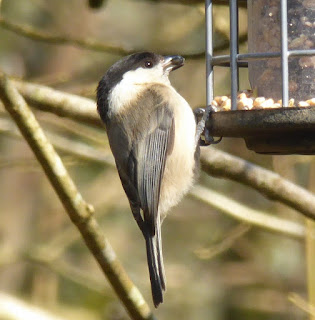I headed off to the woods and fields for a walk while waiting for the low high tide to turn and drop and found 2 green woodpeckers, my first of the year. A flock of around 20 redwings feeding in a grassy field were a surprise along with 4 mistle thrush. The usual woodland birds were seen along with a jay and a nuthatch.
An Early English Bluebell
Male White Wagtail
Canada Geese - smaller female on the left
Canada Geese
Summer Plumaged Cormorant
First Winter Great Black Backed Gull with Herring Gulls
Thursday 17th and it was off to Lower Tamar Lake on the Cornwall/Devon border, not far away from the caravan at Bude but somewhere we have never visited. My target bird was willow tit with regular sightings on the webpages over the winter period of birds feeding on the bird food put out by local birders by the bird hide. I have only seen willow tit once - or have I? I have one record of willow tit in my bird notes, a single bird feeding high in a tree at Brandon on the Suffolk/Norfolk border back in 1989 - I was 99% certain it was a willow and not a marsh and it has remained on my British list at a 99% certainty since. Today was about changing that percentage to 100%.
It was a bright but cold and breezey day and on arrival I headed off straight away to the bird hide and bird feeders while David went off for a walk. On the Lake were a female goosander, a great crested grebe, a summer plumaged cormorant, mallard, moorhen and tufted ducks, and 5 grey heron were resting in the lakeside reeds. A few blue tits and great tits and chaffinch were around the well stocked feeders but after 15 minutes there was no sign of anything else except for a nice male reed bunting and so I decided to go for a walk instead and to return to the hide later.
Male Reed Bunting
The birds were resolutely quiet until I heard the distinctive sneezey pitchou calls of marsh tits. Soon after I heard the distinctive call of willow tit, 2 short notes followed by 4 lower and longer notes and with a buzzing quality - zi-zi-tah-tah-tah-tah - quite unlike a call I have heard before - and then I watched as the bird making the call was seen flitting through the branches chasing after a second bird with a third bird also interacting with them nearby - 3 willow tits!
I managed to get some decent but brief views (and some poor photos) of the willow tits along with marsh tits on the feeders and was able to pick out the diagnostic features for willow tit - pale wing panel, extensive white cheeks, dull black cap, buff brown flanks and lack of white at the bill base - but it was difficult with the birds very active and mobile and the light very bright and harsh. But I had properly seen (and heard) willow tit at last and so we headed off to Bude for lunch and a walk around before driving back to Plymouth.
Willow Tit
Starling, Bude










No comments:
Post a Comment